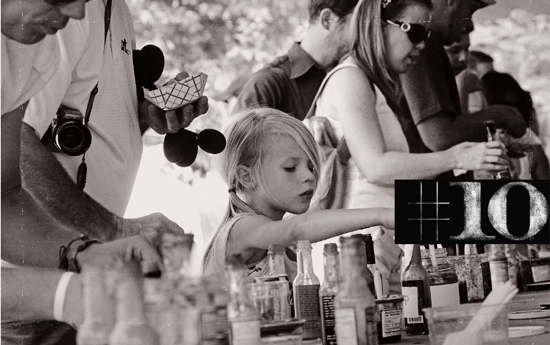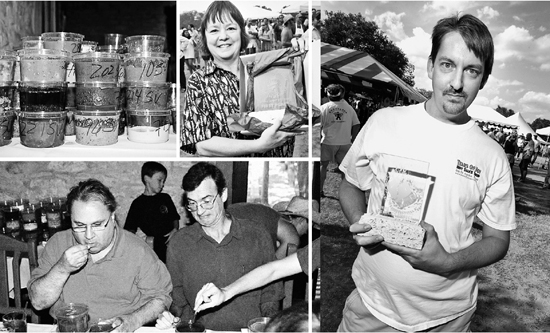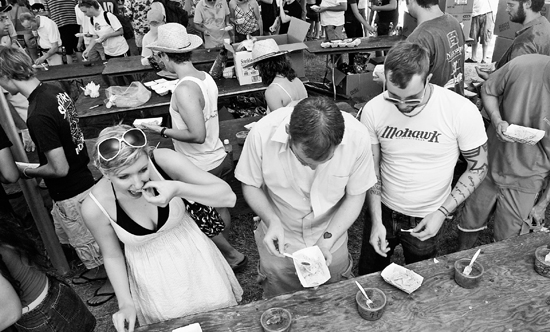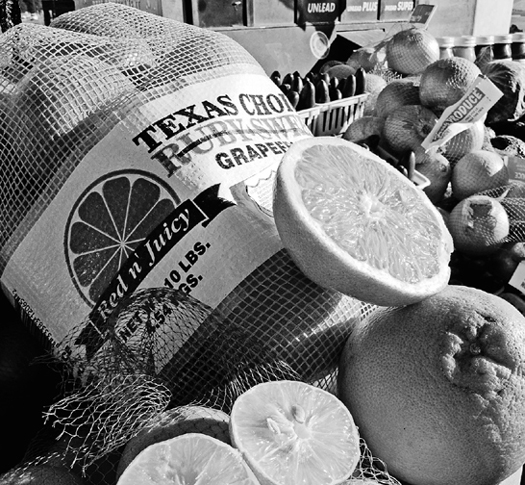
At the Austin Chronicle Hot Sauce Festival in Austin, the crowd lines up to sample the hot sauces
We called it “hot sauce” when I was a student at the University of Texas in the 1970s. Unless you were speaking Spanish, then you said “salsa picante.” At the grocery store, you looked for “picante sauce.” Every Tex-Mex restaurant put a bowl of the stuff on the table. Most of them served it with tortilla chips. In the 1950s and 1960s, before tortilla chips were common, Tex-Mex restaurant patrons ate their hot sauce with buttered saltines. At a few old time-capsule Tex-Mex joints like El Patio in Austin, they still do.
When the Southwestern cuisine came along in the mid-1980s, food lovers started calling it “salsa” and chefs started taking it seriously. Exotic salsas from Mexico’s interior made with all kinds of different chiles began to appear. Habanero salsas, green chile salsas, and salsas with exotic ingredients started turning up. I was the restaurant critic of the Austin Chronicle at the time, and I became a salsa connoisseur.
Jarro Café’s taco truck in Houston offers six varieties of salsa to choose from
In 1990, the Travis County Farmer’s Market sponsored a gardening competition. While the county agent was perfectly willing to judge peaches and watermelons, he wasn’t willing to munch on jalapeño peppers. So Hill Rylander, who ran the farmer’s market, called me and asked me to be the chile judge. I actually bit into some raw jalapeños and picked a winner. But I observed that since few people actually ate raw peppers, it might make more sense to hold a pepper sauce competition. Rylander loved the idea and resolved to hold it the next year.
Around that time, I wrote an article in Chile Pepper magazine calling Austin the hot sauce capital of the world. Predictably, salsa freaks in other cities disagreed. The San Antonio Current, a weekly newspaper in the Alamo City, challenged the Austin Chronicle to a contest—San Antonio versus Austin hot sauces—judged blind by top chefs. The first Hot Sauce Contest, as the event was originally known, was held at the Travis County Farmer’s Market in 1991.
It was held outdoors on a Sunday afternoon in late August—the peak of the chile pepper growing season and the hottest part of the summer. We had a few musicians come and play and we asked a caterer to supply some beer. Austin won and a tradition was born.
There have been lots of changes in the intervening years; the San Antonio versus Austin format was scrapped and the contest was opened to people from anywhere in the world. We invited top Texas chefs like Stephan Pyles and Bruce Auden to be judges. And every year it got bigger. What started out as a contest with a few spectators turned into one of the best parties of the year. When ten thousand people showed up at the Travis County Farmer’s Market one year, traffic came to a halt in north central Austin and we were asked to relocate.
In its seventh year, the Austin Chronicle Hot Sauce Festival, as the event is now officially known, moved to a clearing in the woods of Waterloo Park. There was a lot of apprehension about the move, but as it turned out, the sylvan grove fit the event like an old pair of slippers. The stage tucked neatly between a pair of giant live oaks that kept the bands in the shade. An orderly procession of tents and booths kept the beer and hot sauce flowing nonstop. And plumes of sweet-smelling smoke rising from barbecue rigs, fajita grills, and green-chile roasters put a lovely blue haze on the edges. The contest has been held at Waterloo Park ever since.
The quality of the hot sauces entered has stayed consistent, though the variety has changed. We started out with red and green salsa categories. After a couple of years, we had to add a catch-all category called “special variety” to accommodate the Caribbean tropical fruit sauces that became popular in the mid-1990s. These weren’t the sort of tortilla-chip dips that we were used to. They were sweet and hot salsas that tasted best with grilled fish or grilled pork.
In recent years, we have received around four hundred salsas on average. I would estimate that around 70 percent of the entries are old-fashioned Tex-Mex picante sauces made with tomatoes. These can be divided into the fresh-tasting type frequently seasoned with cilantro, and a smoky-flavored type with smoked tomatoes and chipotles (and occasionally with liquid smoke). Green sauces made with tomatillos represent maybe 10 percent of the total. The other 20 percent or so are entered in the creative “special variety” category.
A curry-flavored Indian sauce won the special-variety category one year. Indonesian sambals, Thai peanut satay sauces, and fruity chutneys have all shown up in the special-variety category along with such oddities as dried cherry salsas, fig salsas, and one that contained coffee grounds. I still remember a dark orange–colored pumpkin habanero salsa from a little South Austin restaurant that won the “Special Variety–Restaurant” category in one of the first years of the contest.

CLOCKWISE FROM TOP LEFT: hot sauce entries; frequent winner Jill Lewis, Austin Slow Burn; frequent winner Brian Rush, Tears of Joy; preliminary judges John Burnett (right) and Bud Kennedy (left)
That pumpkin salsa was so good, I went to the restaurant and asked for it some weeks later. Sadly, it turned out they only made it for special occasions. I still remember that salsa and that little restaurant. It was called Seis Salsas.
There was a circular salsa bar in the middle of the restaurant where you selected your condiments. And every day they put out six different varieties of salsa. I don’t remember much about the food, but I remember the salsas. There was red and green, of course, and fresh chopped pico de gallo. There was a ridiculously hot brick-red chile de árbol sauce and there was always some variety of dark brown dried-chile salsa. And there was a wild card—it could be anything.
Seis Salsas disappeared in the mid-1990s. But the salsa bar concept is still around. It’s an idea worth borrowing for your backyard barbecue. Line up five or six bowls and fill them with several salsas and other appropriate condiments. You’ll be surprised how popular the add-ons really are. Salsa is the difference between good and great. And there’s something about the audience participation involved in seasoning your own tacos that makes them taste better. Here are a couple of standard salsa recipes and a couple of wild ones to get you started. Feel free to experiment.
The Nineteenth Annual Austin Chronicle Hot Sauce Festival in 2009 attracted more than fifteen thousand festival goers. We judged around 425 hot sauces. When you perfect your own salsa recipe, come and enter your hot sauce in the competition.

Austin Chronicle Hot Sauce Festival–goers sample the salsas
3 large tomatoes, quartered
½ onion, sliced in rings
2 cloves garlic, peeled
2 jalapeño peppers, halved lengthwise
1 tablespoon freshly squeezed lemon juice
½ cup chopped fresh cilantro leaves
Salt
2 ripe medium tomatoes, approximately 12 ounces, coarsely chopped
1 jalapeño pepper, stemmed and coarsely chopped
½ large sweet onion, coarsely chopped
1 clove garlic
½ teaspoon salt
Juice of 2 limes
10.75-ounce can tomato puree
⅓ cup chopped onion
¼ cup chopped fresh jalapeño peppers with seeds
2 tablespoons white vinegar
¼ teaspoon salt
¼ teaspoon dried minced onion
¼ teaspoon dried minced garlic

AUSTIN CHRONICLE Hot Sauce Festival entries
1 pound tomatillos, husked and washed
1 cup chopped fresh cilantro leaves
3 fresh serrano chiles, seeded and minced
1 cup minced sweet onion
2 teaspoons minced garlic
Pinch of sugar
¼ cup freshly squeezed lime juice
Sea salt
Chile Pequín hot pepper sauce in a syrup dispenser
3 tablespoons freshly squeezed lime juice
½ cup chopped Texas 1015, Vidalia, Maui, or other sweet onion
2 cups chopped very ripe homegrown or heirloom tomatoes
2 tablespoons minced jalapeño, serrano, or chile pequín peppers
½ teaspoon sea salt
½ teaspoon freshly ground black pepper
2 tablespoons chopped fresh cilantro leaves
Dash of olive oil
½ cup chile pequíns, washed and dried
½ cup white vinegar
Pinch of salt
2 Texas red grapefruits
1 medium tomato, chopped fine
1 cup diced green, red, and yellow bell pepper in any combination
1 jalapeño pepper, seeded and minced
3 tablespoons chopped red onion
1 tablespoon chopped fresh cilantro leaves
Salt to taste

Texas red grapefruits
1 ½ cups diced tomato
½ cup diced red onion
½ cup seeded and small-diced kumquat (unpeeled)
½ cup diced pineapple
½ cup chopped fresh cilantro leaves
¼ cup freshly squeezed orange juice
1 tablespoon habanero hot sauce
Salt to taste
Howling in pain at the Austin Chronicle Hot Sauce Festival
2 cups leftover brewed coffee
1 ancho chile, stemmed and seeded
½ cup raisins
1 teaspoon cocoa powder
4 tablespoons (½ stick) butter
1 cup chopped onion
1 clove garlic, minced
1 tablespoon sherry vinegar
1 tablespoon Worcestershire sauce
1 teaspoon sea salt
½ teaspoon freshly ground black pepper
1 teaspoon freshly ground coffee
2 tablespoons olive oil
1 small onion, sliced thick
5 cloves garlic, peeled and quartered
15 jalapeño peppers, approximately 1 pound, rinsed
1 pound carrots, peeled, rinsed, and sliced ½ inch thick (approximately 2 cups)
1 ¼ cups cider vinegar
1 tablespoon pickling salt, plus more as needed
1 teaspoon ground Mexican oregano
4 bay leaves
White vinegar as needed